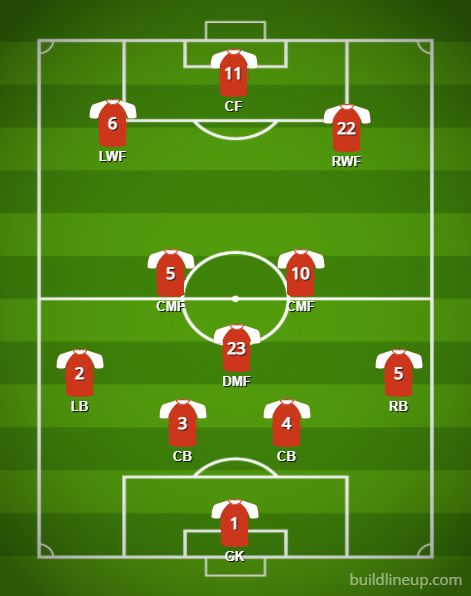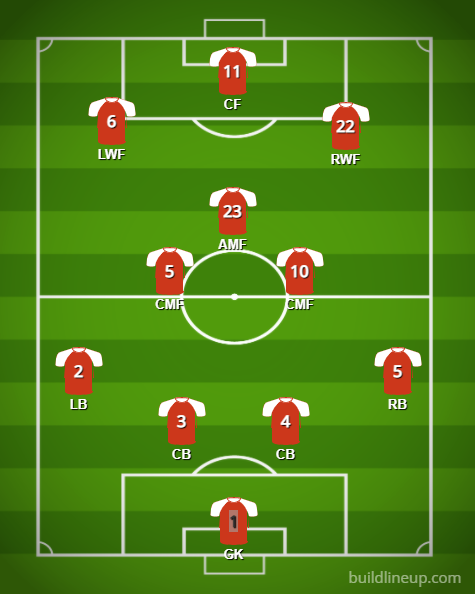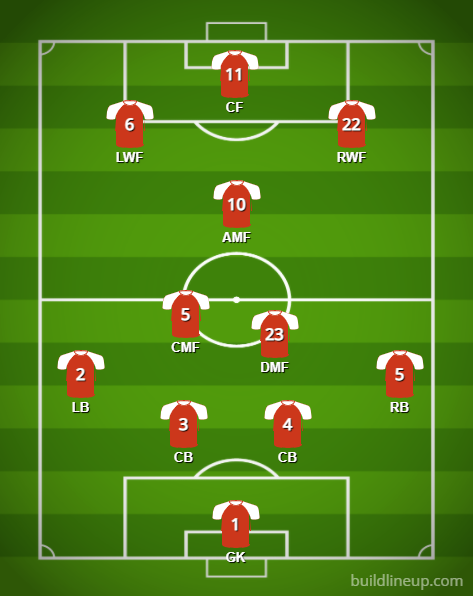
uroPES Super League
An analysis of 433 formation
by Nikos Zaxarias and BilalV, 28th March 2021.
Starting & Defensive:

Attacking:

Alt. Defensive:

Attacking:
1. False Full Back or Attacking Fullbacks
2. Centring Targets
Defensive:
1. Gegenpress or Wing Back
2. Swarm The Box
This formation is also well known, as it is the second most used in the world, being behind only from the 4-4-2. It is called “the Dutch”,
as it was first used in the Netherlands, from where it spread throughout the world. It is a versatile formation, which can be used in many ways,
whether the emphasis is the attack or the defense, plus that it can be the starting point of many variations if the fluid formation is used,
exploiting the best attacking and defensive advantages of each roster – depending on the players that are in the field.
This variation is the attacking one, emphasizing in ball possession and continuous attacks in all the surface of the field.
The starting line-up is the same for every situation, thus 2 CBs, two wing defenders, one DMFs, 2 CMFs, 2 wing attackers and a lone CF. In the attack
the DMF advances to CMF position, while the CMFs become AMFs. One other option, if the manager wants to emphasize in attacking mostly from the center,
is to bring the wing attackers in a more central position as SSs, in order to support the attack with passes from the center.
This is advisable if the opponent gives emphasis in his defense to the wings, thus there is space for attacks from the center.
At the same time, the AMFs are capable of supporting the attacks on the sideline,
especially if they are coupled with attacking fullbacks or powerbacks. When in defense, it becomes a 4-3-2-1,
as the wing attackers drop back as wing midfielders, so as to support the defense in the wings and launch counters with combos with the midfielders and the CF.
As for the player traits that fit in this formation and gamestyle, the CBs are mostly strong and tall players,
capable for clearing the ball with headers and outpower the opponent attackers.
However, it is advisable to combine a Build-up with an Extra Frontman player, so as to make the defense less predictable.
The wing backs, on the other side, are short players, who are faster and more eligible.
Both strategies with False Wingbacks or Attacking Fullbacks work perfectly, depending on where does the player wants the counter,
with the former strategy giving more pressure to the center, while the latter gives more options to the attacks from the wing.
The DMF is absolutely interchangeable with them, according to his strong foot, being able to stay between the CBs and cut the through-balls.
It’s better to have an Orchestrator in this position, as the passes are a must, so as to provide a good clear of the ball towards the attackers,
to start a counter. The CMFs can be one Box-to-box or one Classic 10, in order to support the attack with passes and longshots,
while keeping the CF in the opponent box. These two players are the primary choice for the steady balls (fouls and corners).
If the Anchorman tactic is to be used, it’s better to be applied on the DMF, so as to stay between the CBs.
The two wing attackers who support the attack can be Cross Specialists, Prolific Wingers,
Hole Players or Roaming Flanks, according to what strategy the manager wants.
The first two are used if the managers keep the strong foot on each flank,
thus emphasizing in the crosses, while the last two are better used with reverse-foot tactics,
which means that the wingers here go more offensively and try shots. As for the striker,
the best option is to use a high for, so as to outpower the opposition and clear the way for the wingers to invade or score with the head.
Thus, the best traits for the CF are the Target Man, the Fox in the Box or the Goal Poacher. Note that the AMFs and the two wing attackers are
absolutely interchangeable for all the managers that play in this gamestyle, as the requirements (dribble, speed, attacking prowess and passes)
are equally demanded for both the style of players.
Starting & Defensive:

Attacking:

Alt. Defensive:

Attacking:
1. False Full Back or Attacking Fullbacks
2. False 9 and False wingers
Defensive:
1. Wing Back
2. Swarm The Box
In continuation of the attacking version, this formation is the presentation of the defensive version of the 4-3-3. It is also a versatile formation,
as it can be the starting point of many variations if the fluid formation is used,
exploiting the best attacking and defensive advantages of each roster – depending on the players that are in the field.
Due to the emphasis given in the defensive part,
the whole philosophy gives more importance to prevent the crosses and the invasion and the attacking privileges are fast counters in empty spaces,
going to man-to-man encounters or – ideally – achieving numerical advantage for tet-a-tets.
The starting line-up is the same for every situation, thus 2 CBs, two wing defenders, one DMFs, 2 CMFs, 2 wing attackers and a lone CF.
In the attack, while the DMF and one of the CMFs remain in their positions, the other CMF becomes an AMF and is closer to the attackers.
One other option, if the manager wants to emphasize in attacking mostly from the center, is to bring the wing attackers in a more central position as SSs,
in order to support the attack with passes from the center. This is advisable if the opponent gives emphasis in his defense to the wings,
thus there is space for counters from the center. At the same time, the CMF and the AMF are capable of supporting the attacks on the sideline,
especially if they are coupled with attacking fullbacks. The use of powerbacks is not advised, as there will be gaps in the wings.
When in defense,
it becomes a 4-3-2-1, as the wing attackers drop back as wing midfielders or AMFs (both variations work with equal efficiency),
so as to cover defensively the wings and launch counters with combos with the midfielders and the CF. Finally,
it is also advisable to drop the CF to the SS position when in defense,
so as to be near the middle line to receive the ball and bring it up for an assist that will result in a tet-a-tet.
As for the player traits that fit in this formation and gamestyle, the CBs are mostly strong and tall players,
capable for clearing the ball with headers and outpower the opponent attackers. However,
it is advisable to combine a Build-up with an Extra Frontman player, so as to make the defense less predictable.
The wing backs, on the other side, are short players, who are faster and more eligible. Both strategies with False Wingbacks or Attacking Fullbacks work perfectly,
depending on where does the player wants the counter, with the former strategy giving more pressure to the center,
while the latter gives more options to the attacks from the wing. The DMF is absolutely interchangeable with them, according to his strong foot,
being able to stay between the CBs and cut the through-balls. It’s better to have a Destroyer in this position, so as to cover better the two CBs,
while at the same time the passes provide good clearance to start a counter.
The CMFs can be one Box-to-box or one Classic 10, in order to support the attack with passes and longshots.
The CMF with the Classic 10 trait is the best choice to become the AMF when in the attack – that means that the Box-to-box CMF becomes the deep playmaker.
In the same time, he is the primary choice for the steady balls (foul kicks and corners). If the Anchorman tactic is to be used, it’s better to be applied on the DMF,
so as to stay between the CBs.
The two wing attackers who support the attack can be Cross Specialists, Prolific Wingers, Hole Players or Roaming Flanks, according to what strategy the manager wants.
The first two are used if the managers keep the strong foot on each flank, thus emphasizing in the crosses, while the last two are better used with reverse-foot tactics,
which means that the wingers here go more offensively and try shots. As for the striker, because of the defensive orientation of this system,
it is mostly advisable to use a low for, because his role is not to stay in the box,
but rather play outside of the box and create chances for the wingers via low passes or execute in tet-a-tets with the ball down.
Thus, the best traits for the CF are the Hole Player, the Fox in the Box or the Goal Poacher.
Note that the AMF, the two wing attackers and the CF are interchangeable, as the requirements
(dribble, speed, attacking prowess and passes) are equally demanded for both the style of players..